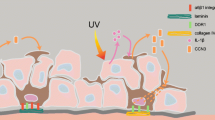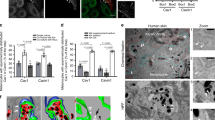Abstract
The process of melanogenesis in melanocytes and the transport of melanin in the form of melanosomes to the neighboring keratinocytes are the key steps in human skin pigmentation. Keratinocytes and melanocytes interact in intricate manner to maintain the homeostasis. The present study was designed to understand the role of cell-cell interaction through the gap junctions between melanocytes and keratinocytes on melanogenesis. We show that, inhibition of the gap junctional activity between human keratinocytes and melanocytes in a coculture system using gap junction blocker lowers the expression of key regulatory genes of melanogenesis such as tyrosinase and microphthalmiaassociated transcription factor (MITF). This was followed by concurrent decrease in tyrosinase protein levels and activity. Our results show the preliminary evidence for the regulation of melanogenesis in melanocytes through direct gap junctional communication by keratinocytes. Deciphering the mechanism and factors involved in the process would uncover the significance of gap junctions in melanogenesis.
Similar content being viewed by others
References
Boger D L, Patterson J E, Guan X, Cravatt B F, Lerner R A, Gilula N B (1998). Chemical requirements for inhibition of gap junction communication by the biologically active lipid oleamide. Proc Natl Acad Sci USA, 95(9): 4810–4815
Costin G E, Hearing V J (2007). Human skin pigmentation: melanocytes modulate skin color in response to stress. FASEB J, 21(4): 976–994
Dbouk H A, Mroue R M, El-Sabban M E, Talhouk R S (2009). Connexins: a myriad of functions extending beyond assembly of gap junction channels. Cell Commun Signal, 7(1): 4
Evans W H, Martin P E (2002). Gap junctions: structure and function. Mol Membr Biol, 19(2): 121–136
Fonseca P C, Nihei O K, Savino W, Spray D C, Alves L A (2006). Flow cytometry analysis of gap junction-mediated cell-cell communication: advantages and pitfalls. Cytometry A, 69(6): 487–493
Goldberg G S, Valiunas V, Brink P R (2004). Selective permeability of gap junction channels. Biochim Biophys Acta, 1662(1–2): 96–101
Gu S, Yu X S, Yin X, Jiang J X (2003). Stimulation of lens cell differentiation by gap junction protein connexin 45.6. Invest Ophthalmol Vis Sci, 44(5): 2103–2111
Hirobe T (2005). Role of keratinocyte-derived factors involved in regulating the proliferation and differentiation of mammalian epidermal melanocytes. Pigment Cell Res, 18(1): 2–12
Hsu M, Andl T, Li G, Meinkoth J L, Herlyn M (2000). Cadherin repertoire determines partner-specific gap junctional communication during melanoma progression. J Cell Sci, 113(Pt 9): 1535–1542
Mese G, Richard G, White T W (2007). Gap junctions: basic structure and function. J Invest Dermatol, 127(11): 2516–2524
Otreba M, Rok J, Buszman E, Wrzesniok D (2012). Regulation of melanogenesis: the role of cAMP and MITF. Postepy Hig Med Dosw (Online), 66: 33–40
Park H Y, Kosmadaki M, Yaar M, Gilchrest B A (2009). Cellular mechanisms regulating human melanogenesis. Cell Mol Life Sci, 66 (9): 1493–1506
Roméro-Graillet C, Aberdam E, Biagoli N, Massabni W, Ortonne J P, Ballotti R (1996). Ultraviolet B radiation acts through the nitric oxide and cGMP signal transduction pathway to stimulate melanogenesis in human melanocytes. J Biol Chem, 271(45): 28052–28056
Sherman A, Rinzel J (1991). Model for synchronization of pancreatic beta-cells by gap junction coupling. Biophys J, 59(3): 547–559
Suadicani S O, Flores C E, Urban-Maldonado M, Beelitz M, Scemes E (2004). Gap junction channels coordinate the propagation of intercellular Ca2+ signals generated by P2Y receptor activation. Glia, 48(3): 217–229
Watanabe M, Iwashita M, Ishii M, Kurachi Y, Kawakami A, Kondo S, Okada N (2006). Spot pattern of leopard Danio is caused by mutation in the zebrafish connexin41.8 gene. EMBO Rep, 7(9): 893–897
Watanabe M, Kondo S (2012). Changing clothes easily: connexin41.8 regulates skin pattern variation. Pigment Cell Melanoma Res, 25(3): 326–330
Zhou J Z, Jiang J X (2014). Gap junction and hemichannel-independent actions of connexins on cell and tissue functions—an update. FEBS Lett, 588(8): 1186–1192
Author information
Authors and Affiliations
Corresponding author
Rights and permissions
About this article
Cite this article
Padma, D., Satyamoorthy, K. & Bhat, K.M.R. Role of gap junctions between keratinocyte and melanocyte in melanogenesis. Front. Biol. 10, 495–502 (2015). https://doi.org/10.1007/s11515-015-1381-z
Received:
Accepted:
Published:
Issue Date:
DOI: https://doi.org/10.1007/s11515-015-1381-z




